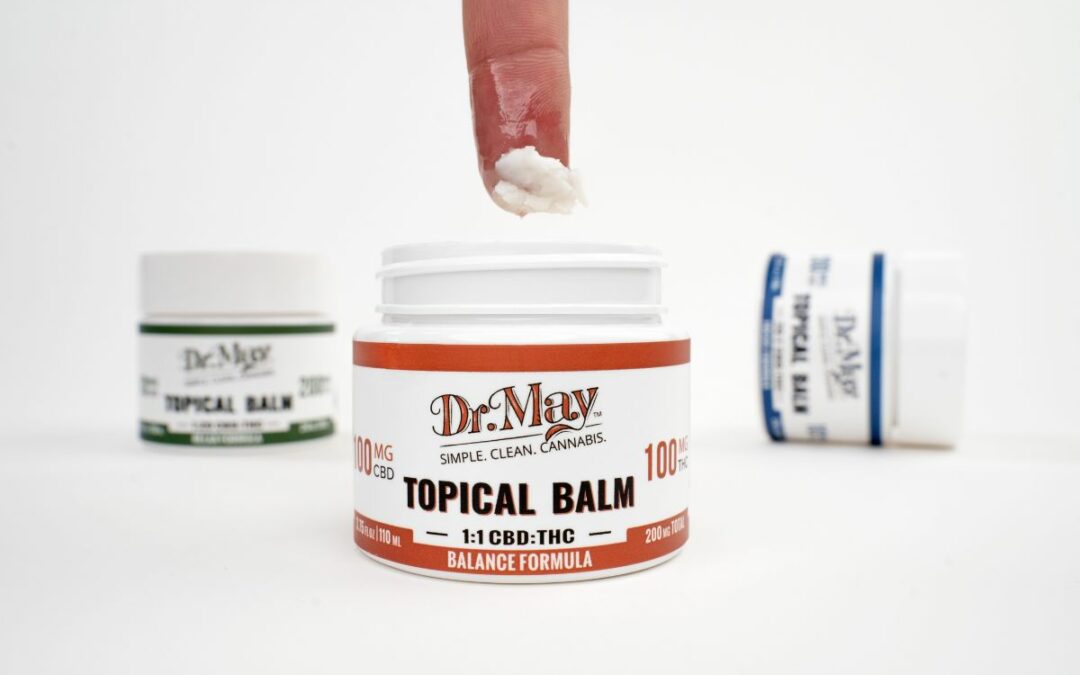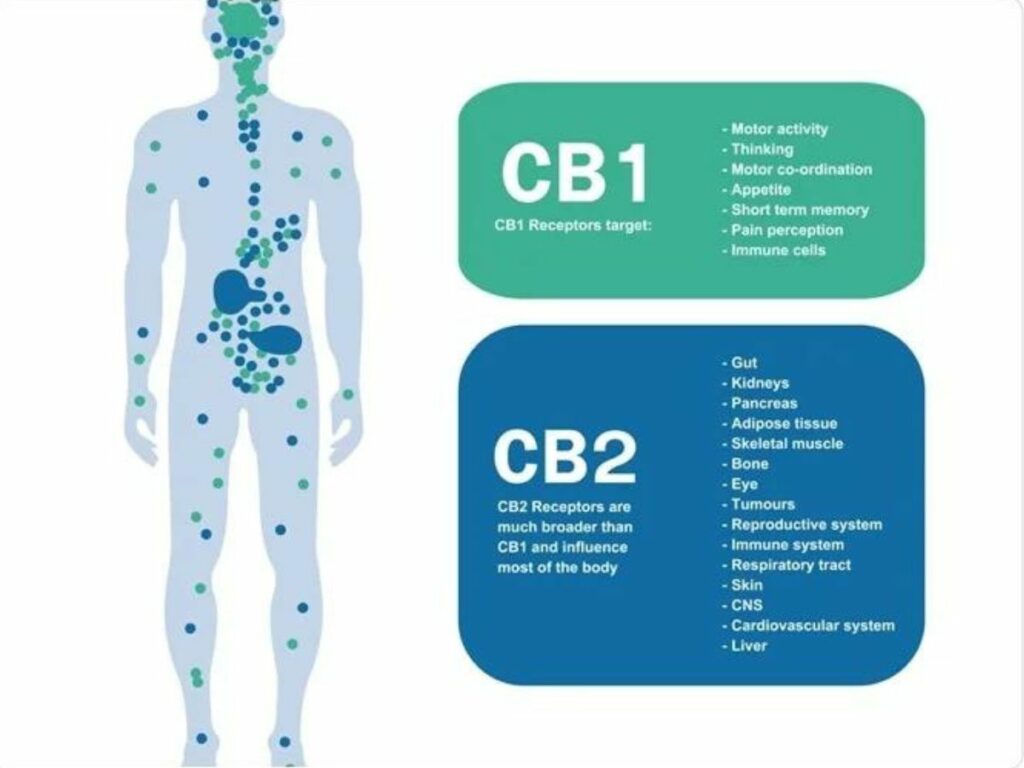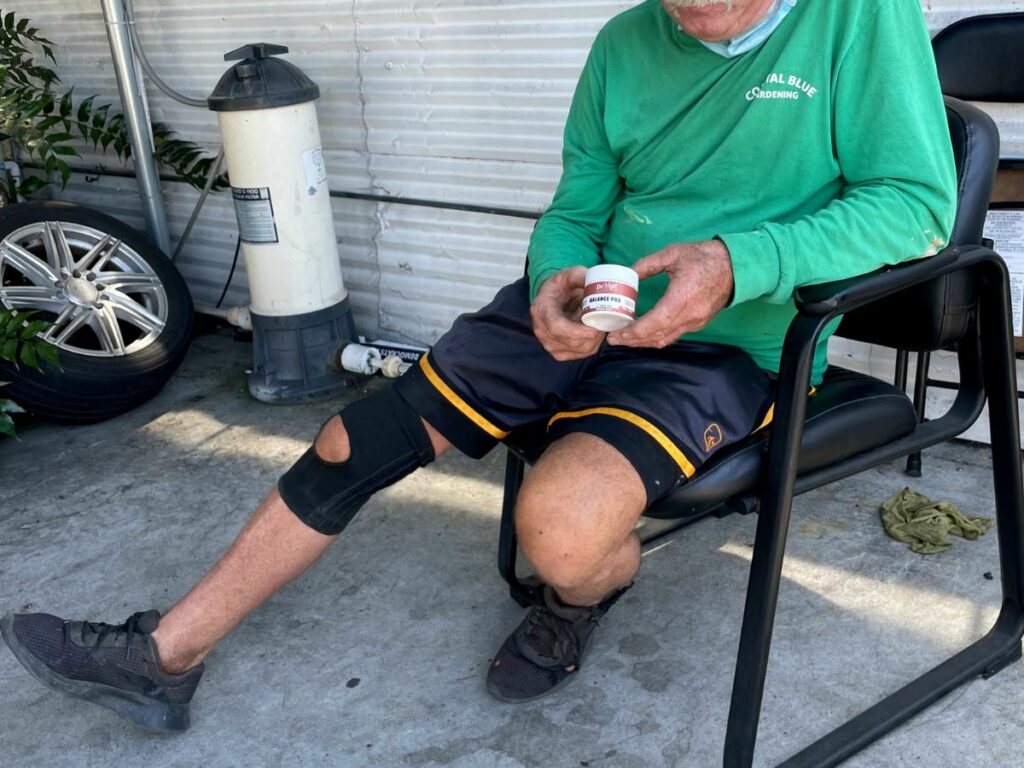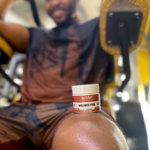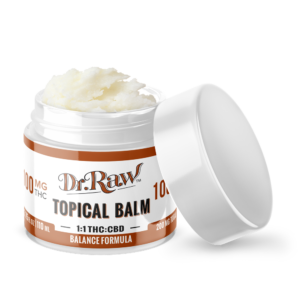The human body is a complex network of interconnected systems, each working together to maintain balance and promote overall well-being. One of the most fascinating discoveries in recent years has been the presence of cannabinoid receptors (CB receptors) in various parts of the body, including the skin. These CB receptors play a crucial role in the body’s endocannabinoid system (ECS), a regulatory system that helps maintain physiological equilibrium. In this article, we’ll delve into the intriguing world of CB receptors in the skin and explore how cannabis topicals communicate with these receptors to potentially offer therapeutic benefits and relief from ailments such as chronic pain, arthritic inflammation and psoriasis.
The Endocannabinoid System: A Brief Overview
Before we dive into the specifics of CB receptors in the skin, let’s take a quick look at the endocannabinoid system (ECS). The ECS is a complex cell-signaling system found in all mammals, including humans. It consists of three main components: endocannabinoids, enzymes that synthesize and break down endocannabinoids, and cannabinoid receptors.
CB1 and CB2 Receptors
Cannabinoid receptors come in two primary types: CB1 and CB2. CB1 receptors are primarily located in the central nervous system (brain and spinal cord), while CB2 receptors are found predominantly in immune cells and peripheral tissues, including the skin. CB receptors are part of a signaling network that helps regulate various bodily functions, including pain perception, immune response, and inflammation. The skin, being the largest organ of the human body, is home to a significant number of CB receptors. CB1 and CB2 receptors in the skin are involved in modulating pain sensation, controlling inflammation, and influencing various skin conditions.
Cannabis Topicals and CB Receptors in the Skin
Cannabis, a plant that has been used for centuries for its potential therapeutic properties, contains compounds called cannabinoids. Two well-known cannabinoids are tetrahydrocannabinol (THC) and cannabidiol (CBD). When applied to the skin in the form of topicals, such as creams, balms, and lotions, cannabinoids interact with the CB receptors present in the skin’s ECS. CBD is non-psychoactive and has gained attention for its potential anti-inflammatory and analgesic properties. When applied topically, CBD interacts with CB2 receptors in the skin, potentially modulating immune responses and reducing inflammation. This interaction may contribute to the relief of localized pain and skin conditions such as eczema and psoriasis. THC is renowned for its psychoactive effects, but it also has potential therapeutic properties when used in the form of topicals. When THC is applied to the skin, it interacts with CB receptors, primarily CB1, which are distributed throughout the body, including the skin. This interaction can have localized effects, potentially providing relief from pain and discomfort. The engagement of CB1 receptors by THC may influence the perception of pain by modulating neural pathways. However, it’s important to note that THC’s psychoactive properties do not typically manifest when used topically due to minimal systemic absorption, reducing the risk of intoxication. As with CBD topicals, further research is necessary to fully comprehend the intricacies of THC’s interaction with CB receptors in the skin and its potential therapeutic benefits.
Benefits of Cannabis Topicals
Cannabis topicals offer several potential benefits due to their interaction with CB receptors in the skin:
- Pain Relief: By interacting with CB1 and CB2 receptors, cannabis topicals may help alleviate localized pain and discomfort. They have been used to manage conditions such as arthritis, muscle soreness, and neuropathic pain.
- Inflammation Reduction: CB receptors play a role in modulating the body’s inflammatory responses. Cannabis topicals may help reduce inflammation in specific areas when applied to the skin.
- Skin Conditions: CB receptors in the skin are implicated in various skin conditions, including acne, eczema, and psoriasis. Cannabis topicals have shown promise in managing these conditions by targeting CB receptors and promoting a balanced immune response.
- Targeted Relief: Cannabis topicals allow for targeted application, delivering cannabinoids directly to the affected area without the need for systemic absorption, which may be desirable for some users.
When exploring the world of cannabis topicals, it’s essential to understand the distinction between transdermal and non-transdermal options. Both types offer unique benefits and applications, catering to varying therapeutic needs.
Non-Transdermal Cannabis Topicals
Non-transdermal cannabis topicals, such as creams, balms, and lotions, are designed to be applied directly to the skin’s surface. These products work primarily on the localized area where they are applied, interacting with cannabinoid receptors in the skin’s endocannabinoid system. While some cannabinoids may penetrate the skin barrier and provide localized relief from pain, inflammation, and skin conditions, they generally do not reach the bloodstream in significant amounts. As a result, non-transdermal topicals are less likely to produce systemic effects, making them a popular choice for targeted relief without the risk of psychoactive experiences.
All Dr. May’s topical products are non-transdermal and are formulated to be applied every 4-5 hours for consistent relief without the psychoactive effects. Dr. May’s topical balms are specially formulated with a blend of cannabinoids, skin soothing and protecting butters and oils and beneficial essential oils such as eucalyptus, white camphor, lemongrass and wintergreen, creating a synergistic effect that maximizes their healing potential.
Transdermal Cannabis Topicals
Transdermal cannabis topicals take the concept of localized relief a step further by incorporating specialized formulations that allow cannabinoids to penetrate through the skin and into the bloodstream. These products often come in the form of patches, gels, or creams with permeation-enhancing agents. Transdermal topicals are designed to deliver cannabinoids systemically, potentially offering effects beyond the localized area of application. Due to their ability to cross the skin barrier, transdermal topicals have the potential to produce more widespread effects, making them suitable for managing conditions like chronic pain or for individuals seeking a more comprehensive therapeutic experience. However, it’s important to note that transdermal topicals may also carry a higher risk of psychoactive effects, particularly if they contain significant amounts of THC. The choice between transdermal and non-transdermal cannabis topicals depends on the desired therapeutic outcome. Non-transdermal options are ideal for targeted relief without the risk of systemic effects, making them suitable for managing localized discomfort and skin issues. On the other hand, transdermal topicals offer the potential for broader effects and may be useful for addressing more widespread concerns, but users should be mindful of potential psychoactive effects, especially with THC-containing formulations. As always, consulting a healthcare professional and carefully reading product labels are recommended before incorporating cannabis topicals into your wellness routine.
In summary, the presence of CB receptors in the skin has opened up new avenues for exploring the therapeutic potential of cannabis topicals. These topicals interact with CB receptors to potentially provide relief from pain, inflammation, and various skin conditions. As research in this field continues to expand, we may gain a deeper understanding of how cannabis topicals communicate with the body’s CB receptors and how they can be effectively integrated into holistic approaches to wellness.
It’s important to note that while cannabis topicals show promise, individual experiences may vary, and more research is needed to fully elucidate their mechanisms of action and therapeutic effects. As with any health-related decision, consulting a healthcare professional is advisable before incorporating cannabis topicals into your skincare or pain management routine.
In the fascinating realm of cannabis topicals, understanding the nuances between different types is crucial for making informed choices that align with your wellness goals. As we’ve explored, the endocannabinoid system’s presence in the skin opens up opportunities for targeted relief and potential therapeutic benefits. As we continue to unveil the intricacies of the endocannabinoid system and its interaction with cannabis compounds, individuals seeking the benefits of cannabis topicals are encouraged to consult healthcare professionals, carefully consider their preferences, and select the type that aligns best with their unique needs. With ongoing research and a growing understanding of the potential therapeutic effects, cannabis topicals stand at the forefront of innovative wellness solutions that harness the power of the endocannabinoid system and the skin’s receptors.

